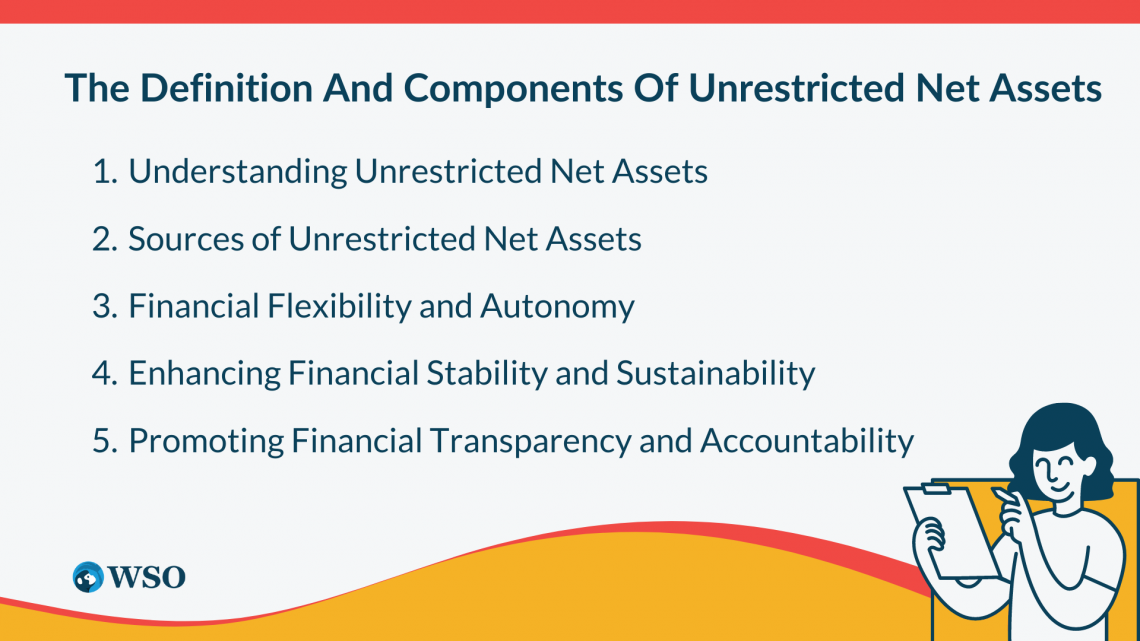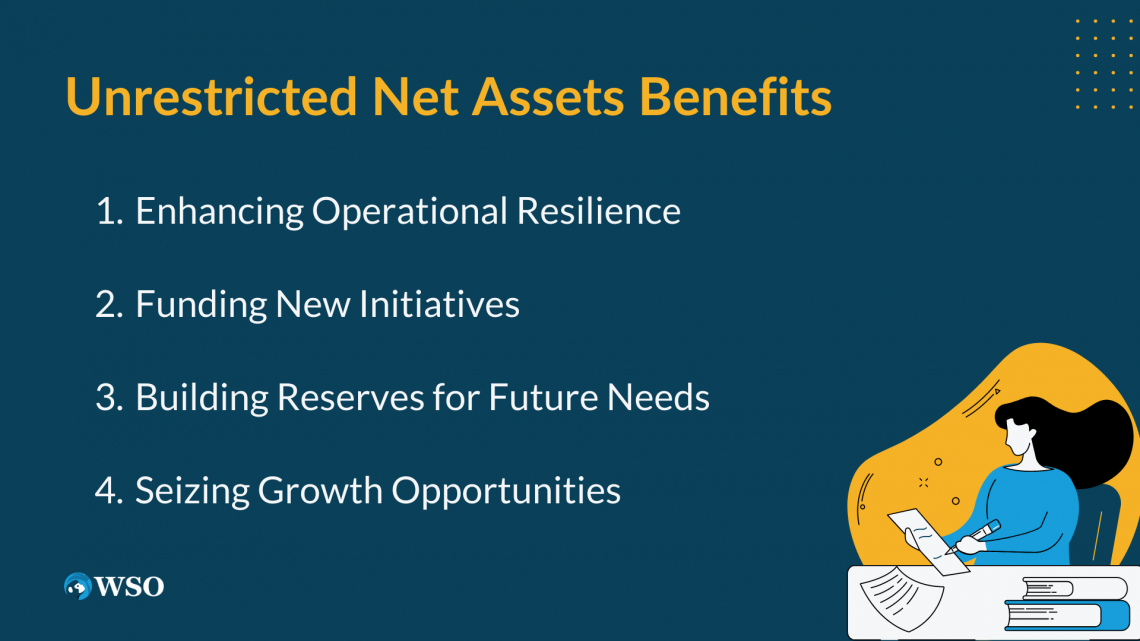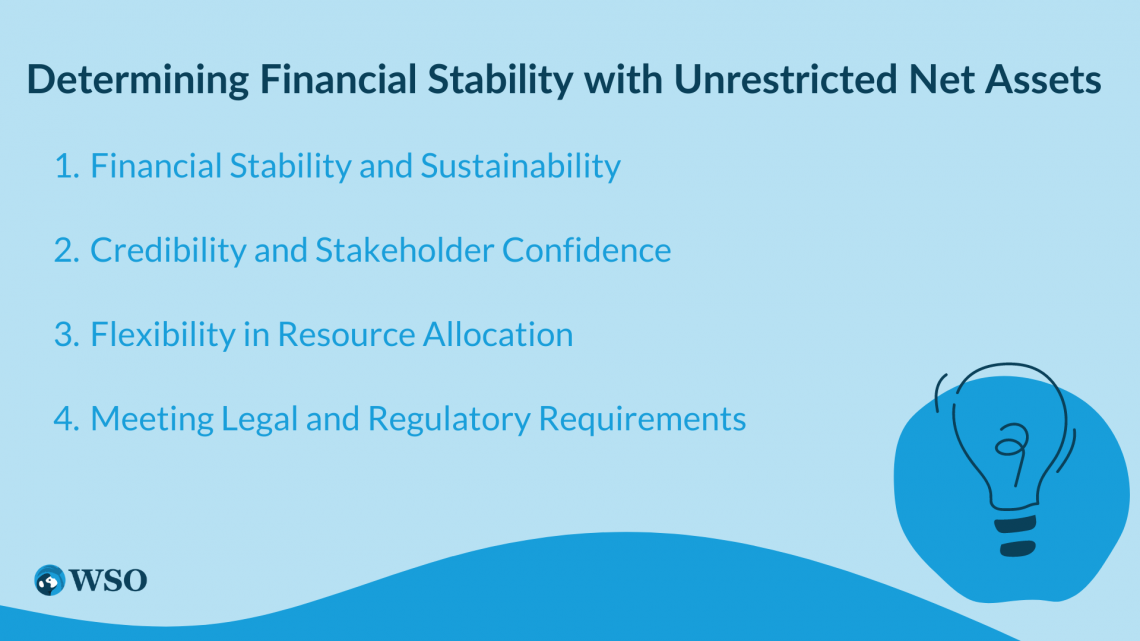Unrestricted Net Assets
It provide organizations with flexibility and financial stability, supporting their mission and operations
Within financial management, an essential element that holds substantial significance is unrestricted net assets.

These assets represent a critical component of an organization's financial framework. These assets offer valuable insights into the entity's financial health and capacity to pursue its mission effectively.
Unlike restricted funds, which are subject to specific donor-imposed conditions or external restrictions, net assets provide the organization with the flexibility and autonomy to allocate resources as deemed necessary.
The concept of unrestricted net assets encompasses various financial resources an organization possesses, including revenues, investment returns, and unrestricted donations.
These funds are not bound by donor-designated purposes or external mandates, enabling the organization to utilize them to further its mission, support ongoing operations, or invest in future growth and sustainability.
The importance of net assets becomes evident when considering the overall financial stability of an organization. A healthy pool of assets serves as a cushion during times of financial uncertainty or unexpected challenges.

It allows the organization to maintain continuity in its operations, meet its financial obligations promptly, and navigate through economic downturns or unforeseen circumstances without compromising its mission.
Furthermore, unrestricted assets play a vital role in demonstrating an organization's financial viability and accountability. Donors, investors, and stakeholders often assess an organization's financial health by examining its net assets.
By leveraging unrestricted assets effectively, organizations can strategically allocate resources to drive innovation, implement growth strategies, and seize opportunities.
In this article, we will delve into the importance of unrestricted net assets and how they contribute to the overall financial stability of an organization.
Key Takeaways
- Restricted funds are donations or grants that come with specific conditions or purposes outlined by donors and are designated for specific projects, programs, or initiatives.
- In contrast to restricted funds, unrestricted net assets offer financial flexibility and adaptability and are not subject to external restrictions, and can be used at the organization's discretion.
- Unrestricted net assets contribute to financial transparency and accountability, reflecting sound financial management practices and building trust among supporters.
- Sources of unrestricted net assets include revenues, investment returns, and unrestricted donations, allowing organizations to allocate resources based on priorities and strategic initiatives.
- Balancing restricted and unrestricted funds is essential for financial stability, as it allows organizations to meet donor intentions while maintaining flexibility, focus on their mission, and mitigate risks.
The Definition and Components of Unrestricted Net Assets
Unrestricted net assets, comprising funds free from external restrictions, are vital for organizations to pursue their objectives effectively. Derived from diverse sources like revenues and unrestricted donations, these assets provide financial flexibility and autonomy.

1. Understanding Unrestricted Net Assets
Net assets represent a crucial aspect of an organization's financial landscape. These assets encompass the financial resources that an organization possesses, which are not bound by external restrictions or donor-imposed conditions.
Unlike restricted funds, which are earmarked for specific purposes, unrestricted assets offer flexibility in resource allocation to support the organization's overall objectives.
2. Sources of Unrestricted Net Assets
Unrestricted assets are derived from various sources within an organization.
The primary sources include revenues generated through the organization's operations, investment returns earned on endowments or other investment portfolios, and unrestricted donations received from supporters.
NOTE
These funds are not tied to any specific program or project, allowing the organization to utilize them based on its priorities and strategic initiatives.
3. Financial Flexibility and Autonomy
The presence of net assets provides an organization with financial flexibility and autonomy. These assets serve as a safety net during times of financial uncertainty or unexpected challenges.
With a healthy pool of unrestricted assets, an organization can promptly maintain its operations, meet financial obligations, and adapt to changing circumstances without compromising its mission or vision.
4. Enhancing Financial Stability and Sustainability
Unrestricted assets contribute significantly to an organization's overall financial stability and sustainability. They offer a cushion that can be utilized to mitigate risks, address unforeseen expenses, and invest in long-term growth and development.
NOTE
By maintaining a strong level of net assets, an organization can weather economic downturns, seize strategic opportunities, and ensure the continuity of its programs and services.
5. Promoting Financial Transparency and Accountability
Unrestricted net assets play a vital role in demonstrating an organization's financial transparency and accountability. Donors, investors, and stakeholders often evaluate an organization's financial health by examining its net assets.
A substantial amount of unrestricted assets indicates sound financial management practices and builds trust among supporters who value transparency and stability.
These assets, derived from various sources such as revenues, investment returns, and unrestricted donations, provide flexibility and autonomy in resource allocation.
By bolstering financial stability, promoting transparency, and enabling long-term sustainability, net assets contribute significantly to an organization's success and impact.
NOTE
Organizations that effectively manage and leverage their unrestricted assets can navigate challenges, seize opportunities, and fulfill their mission with resilience and financial integrity.
Unrestricted Net Assets Benefits
Unrestricted net assets empower organizations with financial flexibility, enabling them to cover expenses, invest in new ventures, and build reserves.

With unrestricted net assets, organizations have the freedom to allocate resources where they are most needed, whether it's addressing immediate expenses, exploring innovative initiatives, or creating financial buffers for future contingencies.
This flexibility strengthens their financial position and ensures their ability to thrive in the face of challenges and uncertainties. Covered below are common benefits provided by Unrestricted Net Assets.
1. Enhancing Operational Resilience
Unrestricted net assets serve as a financial cushion for organizations, providing the necessary resources to cover day-to-day operational expenses.
With a sufficient pool of unrestricted funds, organizations can maintain stability during times of economic uncertainty or unforeseen financial pressures. This flexibility allows them to continue delivering their services and fulfilling their mission without disruption.
2. Funding New Initiatives
Having unrestricted assets allows organizations to pursue new initiatives and expand their programs.
Whether it is launching innovative projects, developing new services, or exploring strategic partnerships, these funds provide the necessary capital to fuel growth and drive positive change.
NOTE
Organizations can adapt to evolving needs by investing in new initiatives and staying relevant in a dynamic environment.
3. Building Reserves for Future Needs
Net assets also enable organizations to establish reserves for future contingencies. By setting aside a portion of these funds, organizations can create a safety net to mitigate risks and navigate unforeseen challenges.
These reserves can be crucial during economic downturns, emergencies, or periods of decreased funding, ensuring the organization's sustainability and ability to continue its operations.
4. Seizing Growth Opportunities
Financial flexibility afforded by unrestricted assets positions organizations to seize growth opportunities as they arise.
Whether it is expanding into new markets, acquiring assets, or scaling existing operations, having available funds can enable organizations to act swiftly and capitalize on strategic opportunities.
NOTE
A robust pool of unrestricted net assets sets the foundation for long-term success and enables organizations to fulfill their mission in an ever-changing financial landscape.
This agility allows organizations to stay competitive, increase their impact, and pursue their long-term goals effectively.
By providing resources for operational resilience, funding new initiatives, building reserves, and seizing growth opportunities, these assets empower organizations to navigate challenges, drive innovation, and make a lasting impact in their respective fields.
Determining Financial Stability with Unrestricted Net Assets
Unrestricted net assets are a crucial measure of an organization's financial strength and accountability.

We will explore how the level of net assets reflects sound financial management, instills stakeholder confidence, and contributes to an organization's ability to fulfill its mission.
Listed below are some financial indicators that can be tied to an organization’s net assets:
1. Financial Stability and Sustainability
A significant amount of unrestricted assets demonstrates an organization's financial stability and sustainability.
It indicates that the organization has sufficient resources to cover expenses, invest in growth, and weather financial challenges. This financial strength enables the organization to fulfill its mission in the long term and maintain its operations even during uncertain economic times.
2. Credibility and Stakeholder Confidence
Unrestricted net assets play a vital role in building credibility and instilling confidence in an organization. Donors, investors, and stakeholders often consider the level of net assets when evaluating an organization's financial health and accountability.
NOTE
A substantial amount indicates effective financial management and responsible use of resources, which enhances the organization's reputation and attracts support from stakeholders.
3. Flexibility in Resource Allocation
Organizations with significant unrestricted assets have greater flexibility in allocating resources. These funds can be strategically directed toward program development, capacity building, or innovation.
The ability to allocate resources based on priorities and emerging needs allows organizations to adapt to changing circumstances and seize opportunities that align with their mission and strategic goals.
4. Meeting Legal and Regulatory Requirements
Maintaining an appropriate level of unrestricted net assets is often a legal or regulatory requirement for nonprofit organizations. Having sufficient reserves ensures compliance with regulations and safeguards against financial instability.
By meeting these requirements, organizations demonstrate their commitment to accountability, transparency, and responsible financial management, reinforcing stakeholder trust.
NOTE
This financial strength not only safeguards the organization's sustainability but also enhances its ability to impact the communities it serves positively.
Unrestricted assets are a critical component of an organization's financial strength and accountability. They provide a measure of financial stability, enhance credibility, enable flexible resource allocation, and ensure compliance with legal and regulatory requirements.
By maintaining a substantial level of net assets, organizations can demonstrate their commitment to sound financial management, inspire stakeholder confidence, and effectively pursue their mission.
Balancing Restricted And Unrestricted Funds
Balancing restricted and unrestricted funds is essential for financial stability.

This article explores how finding the right balance between restricted and unrestricted net assets enables organizations to fulfill their mission, respond to changing needs, and maintain financial flexibility.
1. Meeting Donor Intentions with Restricted Funds
Restricted funds are donations or grants that come with specific conditions or purposes outlined by donors. Organizations must diligently manage and allocate restricted funds according to donor intentions to maintain transparency, accountability, and legal compliance.
2. Flexibility and Adaptability with Unrestricted Net Assets
In contrast to restricted funds, unrestricted assets offer financial flexibility and adaptability.
Having a healthy pool of net assets allows organizations to respond swiftly to unforeseen challenges, invest in strategic opportunities, or address emerging needs that align with their mission and strategic goals.
3. Maintaining Focus on Mission
Striking a balance between restricted and unrestricted funds is crucial to ensure that an organization remains focused on its core mission.
While restricted funds support specific projects or initiatives, net assets provide the necessary resources to sustain ongoing operations, administrative expenses, and the overall organizational mission.
NOTE
Balancing both types of funds helps maintain a sustainable financial model that aligns with the organization's overarching objectives.
4. Financial Resilience and Risk Mitigation
Maintaining a balanced approach between restricted and unrestricted funds enhances an organization's financial resilience and risk mitigation strategies. Relying heavily on restricted funds can lead to vulnerability if a specific project or funding source ends.
Having a diversified funding base that includes unrestricted assets provides stability and reduces dependence on external funding, thus safeguarding against potential financial disruptions.
NOTE
By managing both types of funds effectively, organizations can navigate changing circumstances, ensure long-term financial sustainability, and fulfill their mission with impact and resilience.
Achieving a balance between restricted and unrestricted funds is crucial for financial stability and operational effectiveness.
While restricted funds meet donor intentions and support specific initiatives, net assets provide the necessary flexibility to adapt, invest strategically, and maintain the organization's focus on its mission.
Conclusion
Restricted funds, tied to specific purposes defined by donors, ensure that resources are allocated according to their intentions. On the other hand, unrestricted net assets offer flexibility, enabling organizations to address unforeseen needs and invest strategically.

By striking a balance between the two, organizations can remain focused on their mission while adapting to evolving circumstances.Unrestricted assets play an integral role in financial management, providing organizations with the necessary resources and flexibility to fulfill their missions effectively.
These assets serve as a safety net, empowering organizations to respond swiftly to emerging challenges and seize growth opportunities. By wisely managing assets, organizations can demonstrate accountability and responsible financial stewardship.
By embracing sound financial practices and maintaining a healthy balance between restricted and unrestricted funds, organizations position themselves for long-term success.
This balance ensures that donor intentions are respected while also enabling the organization to navigate uncertainties and pursue strategic initiatives. It establishes a solid foundation for financial stability, allowing organizations to weather financial challenges and confidently pursue their mission.









or Want to Sign up with your social account?